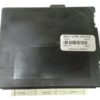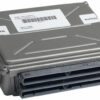Restore Your Truck’s Core Electrical Functions
If you’re dealing with bizarre electrical problems in your 2001 GM truck—like power windows with a mind of their own, flickering dash lights, or a security system that won’t let you start your own vehicle—you’ve likely met the culprit: a failing Body Control Module (BCM). As a technician with over two decades of experience, I’ve seen firsthand how a faulty BCM can turn a reliable workhorse into a source of daily frustration. It’s the central hub for your truck’s body electronics, and when it goes, chaos follows. This isn’t just an annoyance; it’s a matter of function and safety.
This isn’t just a replacement part; it’s a complete solution. We take the hassle and high cost of dealership programming out of the equation. Simply provide us with your vehicle’s VIN after purchase, and our experts will flash this BCM with the latest, most stable software directly from GM. It arrives at your door ready for a straightforward installation, restoring the performance and reliability you depend on. This is the definitive fix for your 2001 Sierra BCM and related GM truck issues.
Case Study: A Tricky Diagnosis
A customer brought in his 2001 Silverado 2500 last month with a classic ghost-in-the-machine problem. The radio would turn on and off, the driver’s side power lock was dead, and the security light was flashing intermittently, sometimes preventing the truck from starting. He had already replaced the battery and checked all the fuses. After connecting my scan tool, I saw multiple communication loss codes with various modules. This is a tell-tale sign. Instead of a dozen separate issues, the problem was the central hub—the BCM. We installed a VIN-programmed module just like this one, and within an hour, every single symptom was gone. It’s a common failure point on these trucks, and a pre-flashed module is the most efficient fix.
Is Your GM Truck Showing These BCM Failure Signs?
A failing BCM can manifest in numerous ways. Check if any of these symptoms sound familiar:
- ✔ Erratic or non-functional power windows, door locks, and interior lights.
- ✔ The security or anti-theft system light stays on, preventing the engine from starting.
- ✔ Horn honking unexpectedly or not working at all.
- ✔ Dashboard warning lights (like the airbag light) illuminating for no reason.
- ✔ Wipers operating intermittently or at incorrect speeds.
- ✔ Communication errors with other vehicle modules when checked with a scan tool.
Your Straightforward BCM Installation Guide
Replacing the 2001 Sierra BCM is a manageable job for a confident DIYer. Follow these steps carefully:
- Safety First: Always disconnect the negative terminal from your vehicle’s battery before working on any electrical components.
- Locate the BCM: On these GM trucks, the BCM is typically located on the driver’s side, up under the dashboard to the left of the steering column.
- Remove Trim Panels: You may need to remove the lower dash knee bolster panel to gain clear access to the module.
- Disconnect and Remove: Carefully unplug the electrical connectors. They have locking tabs, so don’t force them. Once disconnected, unbolt or unclip the old BCM from its mounting bracket.
- Install the New BCM: Mount your new, pre-programmed BCM in the same location and securely reconnect all electrical harnesses.
- Perform Relearn Procedures: Reconnect the battery. As noted below, you will need to perform the ‘Setup SDM Primary Key in BCM’ procedure with a capable scan tool to clear the airbag light. Some vehicles may also require a brake pedal position sensor relearn.
Critical Post-Installation Steps
Important: To ensure full functionality and safety after installing your new BCM, the following procedures are required. Failure to perform these steps can leave warning lights on and systems inoperative.
- Airbag System Reset: You must use a qualified diagnostic scan tool to perform the ‘Setup SDM Primary Key in BCM’ procedure. This syncs the BCM with the airbag module (SDM) and turns off the airbag warning light.
- Brake Pedal Recalibration: Some vehicles require a brake pedal position sensor relearn to ensure proper brake light operation and stability control function.
Note: If you are not comfortable performing these relearn procedures, we strongly recommend seeking assistance from a professional mechanic.
Guaranteed Fitment for These 2001 GM Models
This module is a direct replacement for part numbers 09375899, 9392990, 09370249, and 19180223. It is guaranteed to fit the following 2001 vehicles:
- ✔ 2001 GMC Sierra 1500, 2500, & 3500 Pickup (LH dash)
- ✔ 2001 Chevrolet Silverado 1500, 2500, & 3500 Pickup (LH dash)
- ✔ 2001 Chevrolet Tahoe (LH dash, 4×2, ID 9392990)
- ✔ 2001 Chevrolet Suburban 1500 & 2500 (LH dash, ID 9392990)
- ✔ 2001 GMC Yukon (LH dash, 4×2, ID 9392990)
- ✔ 2001 GMC Yukon XL 1500 & 2500 (LH dash, ID 9392990)
Frequently Asked Questions About the 2001 Sierra BCM
Do I really need to provide my VIN?
Yes, providing your VIN is essential. We use it to program the Body Control Module with the correct GM software and vehicle-specific options, ensuring it works perfectly right out of the box.
What happens if I don’t do the airbag relearn procedure?
If the ‘Setup SDM Primary Key in BCM’ procedure is not completed, the airbag warning light will remain illuminated on your dashboard, and more importantly, the airbag system may not function correctly in an accident.
Can I install this myself?
The physical installation is straightforward for most DIYers. However, you will need access to a bi-directional scan tool capable of performing the required airbag and brake system relearn procedures after installation.
Will this fix my truck’s no-start problem?
If your no-start issue is caused by the anti-theft system (a common BCM failure), then yes, this programmed module will resolve the problem. It restores proper communication so the vehicle recognizes your key.
Is this a brand new part?
This is a high-quality, fully tested replacement part that has been programmed with the latest genuine GM software for your specific vehicle. It is guaranteed to restore original functionality.



